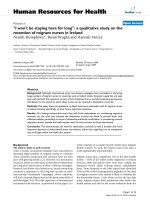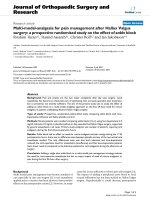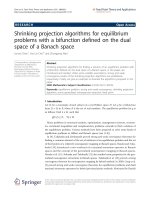On the Berry Esseen bound for a combinatorial central limit theorem
Bạn đang xem bản rút gọn của tài liệu. Xem và tải ngay bản đầy đủ của tài liệu tại đây (286.59 KB, 12 trang )
On the Berry-Esseen bound for a combinatorial
central limit theorem
Th`anh Lˆe Vˇan∗
Abstract
The main finding of this note is an improvement of the Chen-Goldstein-Shao proof of the
Berry-Esseen bound for the combinatorial central limit theorem. A bound of the correct order
in terms of third-moment type quantities with a small explicit constant is obtained. Moreover,
our approach does not need to use a truncation step as in Chen-Goldstein-Shao. An example is
also given to illustrate the optimality of the bound.
Key Words and Phrases: Berry-Esseen bound, combinatorial central limit theorem, zero-bias
coupling, Stein’s method.
2010 Mathematics Subject Classifications: 60F05, 60D05.
1
Introduction and result
Let n ≥ 2 and A = {aij , 1 ≤ i, j ≤ n} be an array of real numbers. In this note, we study the
combinatorial central limit theorem, that is, the central limit theorem for random variables of the
form
n
aiπ(i) ,
Y = YA =
(1.1)
i=1
where π is a random permutation with the uniform distribution over the symmetric group of all
permutations of {1, . . . , n}.
The central limit theorem for YA were proved by Wald and Wolfowitz [17] when the factorization
aij = bi cj holds, and by Hoeffding [11] for general arrays. Bounds on the error in the normal
approximation were later considered by a number of authors. Ho and Chen [10] used a concentration
inequality approach and Stein’s method for exchangeable pairs [16], which yield the optimal rate
only under condition that supij |aij | ≤ C. Bolthausen [1] also used Stein’s method with an inductive
approach, which obtained a bound of the correct order in terms of third-moment type quantities,
but with an unspecified constant. Goldstein [7] employing the zero bias version of Stein’s method
obtained bounds with an explicit constant, but in terms of supi,j |ai,j |. Recently, Chen, Goldstein
∗ Department of Mathematics, Vinh University, Nghe An 42118, Vietnam. A part of research of the second author
is also supported by the Vietnam Institute for Advanced Study in Mathematics (VIASM) and the Vietnam National
Foundation of Sciences and Technology Development (NAFOSTED). Email:
1
and Shao [5, Theorem 6.2] used the zero bias variation of Ghosh [6] on the inductive method in
Bolthausen [1] to prove a bound depending on a third moment type quantity of the matrix, but
with an unspecified constant like Bolthausen [1]. In this note, we give an improvement of the
Chen-Goldstein-Shao proof and obtain a bound of the correct order in terms of third-moment type
quantities with a constant c = 90. Moreover, our approach do not need to use the truncation step
as in [1, 5, 6]. We also give an example to illustrate the optimality of the bound.
As far as we are aware, on bound depending on a third moment type quantity of the matrix,
the best absolute constant is c = 447 which was obtained very recently by Chen and Fang [4].
(Neammanee and Suntornchost [15] obtained a constant c = 198. However, Chen and Fang [4]
showed that the proof in [15] is incorrect.) Both in [4] and [15], the authors used the concentration
inequality approach and method of exchangeable pairs, and considered the case where the elements
of A are independent random variables.
2
We denote the mean and variance of YA by µA and σA
, and use the following notation.
ai. =
1
n
n
aij , 1 ≤ i ≤ n, a.j =
j=1
1
n
It is known that
n
aij , 1 ≤ j ≤ n, and a.. =
i=1
n
ai. =
i=1
aij .
i,j=1
a.π(i) ,
(1.2)
i=1
n
2
=
σA
n
n
µA = na.. =
and
1
n2
n
1
1
(a2 − a2i. − a2.j + a2.. ) =
(aij − ai. − a.j + a.. )2 .
n − 1 i,j=1 ij
n − 1 i,j=1
(1.3)
From (1.2), we automatically get that
n
(aiπ(i) − ai. − a.π(i) + a.. ).
YA − EYA =
(1.4)
i=1
We also denote WA = (YA − µA )/σA and
βA =
n
i,j=1
|aij − ai. − a.j + a.. |3
3
σA
.
(1.5)
1
x
Throughout this note, Z is the standard normal random variable, Φ(x) = √
exp(−t2 /2)dt
−∞
2π
is the distribution function of Z. For n ≥ 1, let Sn denote the symmetric group of all permutations
of {1, . . . , n}, and let π denote a random permutation with the uniform distribution over Sn . For a
set S, the indicator function of S is denoted by 1(S) and the cardinal of S is denoted by |S|.
The following theorem will be proved in this note.
Theorem 1.1. We have
sup |P (WA ≤ x) − Φ(x)| ≤
x∈R
2
90βA
.
n
(1.6)
Let aij = aj for 1 ≤ i ≤ m and aij = 0 for m < i ≤ n, where 1 ≤ m < n and A = {a1 , . . . , an } is
a set. Then YA = X1 + · · · + Xm , where {X1 , . . . , Xm } is a random sampling without replacement
of size m from A. In this case, it is easy to see that with a
¯=
m(n − m)[(n − m)2 + m2 ]
βA
=
n
n4 (V arX)3/2
n
j=1
|aj − a
¯ |3
≤
n
j=1
aj /n,
m(n − m)
n
j=1
|aj − a
¯ |3
n2 (V arX)3/2
.
Therefore, we have the following corollary.
Corollary 1.2. Let X = X1 + · · · + Xm , where {X1 , . . . , Xm } is a random sampling without replacement of size m from A = {a1 , . . . , an }. Then
n
90m(m − n) j=1 |aj − a
¯ |3
X − EX
sup P √
≤ x − Φ(x) ≤
.
n2 (V arX)3/2
V arX
x∈R
H¨
oglund [12] proved this corollary with the same bound but without an explicit constant by
Fourier analysis. More recently, Goldstein [8] obtained the Wasserstein distance to the normal
distribution, and Hu, Robinson, and Wang [13] proved the Cram´er-type large deviations for X.
2
Proof
In view of (1.4) and (1.5), we may replace aij by
aij − ai. − a.j + a..
σA
2
= 1.
and assume a.. = ai. = a.j = 0, σA
It was shown by Goldstein and Reinert [9] that for any mean zero random variable W with
finite variance σ 2 , there exists a random variable W ∗ which satisfies EW f (W ) = σ 2 Ef (W ∗ ) for
all absolutely continuous f with E|W f (W )| < ∞. We say that such a W ∗ has the W -zero biased
distribution. Before present the proof of the theorem, we recall the zero-bias coupling construction
for Y = YA in Goldstein [8] as follows.
Choose I † , J † , K † , L† independently of the remaining random variables, with distribution
P (I † = i, J † = j, K † = k, L† = l) =
(aik + ajl − ail − ajk )2
.
4n2 (n − 1)
For 1 ≤ i, j ≤ n, let τij be the permutation which transposes i and j. Set
if L† = π(I † ), K † = π(J † ),
πτπ−1 (K † ),J †
π † = πτπ−1 (L† ),I †
if L† = π(I † ), K † = π(J † ),
πτπ−1 (K † ),I † τπ−1 (L† ),J † otherwise ,
and π ‡ = π † τI † ,J † . Then {π † (I † ), π † (J † )} = {π ‡ (I † ), π ‡ (J † )} = {K † , L† }. Let
I = {I † , J † , π −1 (K † ), π −1 (L† )},
3
and let Y † and Y ‡ be random variables given by (1.1) with π replaced by π † and π ‡ , respectively.
Then, with U is the uniform distribution on [0, 1] independent of the remaining random variables,
Goldstein [8] showed that
Y ∗ = U Y † + (1 − U )Y ‡
(2.1)
Y = S + T, Y † = S + T † , Y ‡ = S + T ‡ ,
(2.2)
has Y -zero biased distribution, and
where
aiπ(i) , T † =
aiπ(i) , T =
S=
i∈I
/
i∈I
aiπ† (i) and T ‡ =
i∈I
aiπ‡ (i) .
(2.3)
i∈I
Let 2 ≤ l ≤ 4, and D = {dij , 1 ≤ i, j ≤ n − l} be the (n − l) × (n − l) array formed by removing
the l rows R ⊂ {1, . . . , n} and l columns C ⊂ {1, . . . , n} from A. Let E = {eij , 1 ≤ i, j ≤ n − l} be
a matrix with
eij = (dij − di. − d.j + d.. )/σD .
2
It follows that ei. = e.j = e.. = µE = 0, σE
= 1, βE = βD .
For x > −1 and 0 < α < 1, let hx,α (ω) be the function which is 1 for ω ≤ x and then drops
linearly to the value 0 at x + α and is 0 for ω ≥ x + α. Let g(ω) = (ωf (ω)) , where f = fx,α be the
unique bounded solution of the Stein equation
f (ω) − ωf (ω) = h(ω) − Eh(Z).
For an arbitrary random variable X and a ≤ b, we will use the following simple fact
b−a
P (a ≤ X ≤ b) ≤ √
+ 2 sup |P (X ≤ x) − Φ(x)|.
2π
x∈R
(2.4)
The proof of the following lemma is easy, and will be presented in Appendix.
Lemma 2.1. Assume that n > 25000 and
βA
1
<
.
n
160
(2.5)
2
σD
≥ 0.93, and βE = βD ≤ 1.153βA .
(2.6)
Then
Proof of Theorem 1.1. For β > 0, set
2
M (β, n) = A ∈ Rn×n : ai. = a.j = 0, σA
= 1, βA ≤ β ,
δ(β, n) = sup |P (WA ≤ x) − Φ(x)|, x ∈ R, A ∈ M (β, n) .
4
If A ∈ M (β, n), then −A ∈ M (β, n) and
|P (W−A ≤ x) − Φ(x)| = |P (WA ≥ −x) − (1 − Φ(−x))|
= |P (WA < −x) − Φ(−x)|.
Therefore
δ(β, n) = sup |P (WA ≤ x) − Φ(x)|, x ≥ 0, A ∈ M (β, n) .
We then follow the computation in Chen and Shao [2, p. 246] to get
δ(β, n) ≤ sup
x≥0
1
− (1 − Φ(x)) ≤ 0.55.
1 + x2
(2.7)
It suffices to prove that
sup
β>0
nδ(β, n)
≤ 90 for all n ≥ 2.
β
(2.8)
If 2 ≤ n ≤ 25000, then for all β > 0 and A ∈ M (β, n), it easy to see that (see, e.g., [5, p. 171])
βA
(n − 1)3/2
1
≥
>
.
n
n2
160
(2.9)
Combining (2.7) and (2.9), we see that (2.8) holds for 2 ≤ n ≤ 25000. Assuming that n > 25000
and (2.8) holds for all m ≤ n − 1, we will prove that it also holds for n.
Fix β > 0, by (2.7), we may assume that β/n < 1/160. Let A ∈ M (β, n) be arbitrary, we will
prove that
sup |P (WA ≤ x) − Φ(x)| ≤
x≥0
Firstly, we consider x such that
90βA
.
n
(2.10)
(1 + x)βA
1
≥
. In this case, we have
n
84
|P (YA ≤ x) − Φ(x)| = |P (YA > x) − (1 − Φ(x))|
≤ max{P (YA > x), 1 − Φ(x)}
1
E(YA + 1)2
,
}
(1 + x)2 1 + x
2
1
= max{
,
}
(1 + x)2 1 + x
1.05
89βA
≤
≤
.
1+x
n
≤ max{
(1 + x)βA
1
<
. Let h = hx,α be defined earlier and f be the
n
84
†
solution to the Stein’s equation for this h. Let YA , YA‡ , YA∗ , S, T , T † , T ‡ be written as in (2.1), (2.2)
It remains to consider the case
5
and (2.3), we have
|Eh(YA ) − Eh(Z)| = |Ef (YA ) − EYA f (YA )| = |E(f (YA ) − f (YA∗ ))|
≤ |E(YA f (YA ) − YA∗ f (YA∗ ))| + |h(YA∗ ) − h(YA )|
= E (S + T )f (S + T ) − (S + U T † + (1 − U )T ‡ )f (S + U T † + (1 − U )T ‡ )
1
+ E |YA∗ − YA |
α
:= R1 + R2 .
1
I[x,x+α] (YA +
r(YA∗
(2.11)
− YA ))dr
0
Let I = (I † , J † , π −1 (K † ), π −1 (L† ), π(I † ), π(J † ), K † , L† ) and B = σ(I, U ). By (2.3), we see that
T, T † , T ‡ are measurable with respect to B. Therefore
T
g(S + u)du
R1 = E
U T † +(1−U )T ‡
T
E B g(S + u)du
= E
(2.12)
U T † +(1−U )T ‡
T
E I g(S + u)du (by the independence of U from {I, S}).
= E
U T † +(1−U )T ‡
Let R = I = {I † , J † , π −1 (K † ), π −1 (L† )}, C = {π(I † ), π(J † ), K † , L† }, l = |I|. Denote YD =
n−l
i=1
diθ(i) , where θ is a random permutation with the uniform distribution over Sn−l . Since S =
i∈I
/
diπ(i) and π is chosen uniformly from Sn , we have
L(S|I = i) = L(YD ) for all i.
(2.13)
E {I=i} g(S + u) = Eg(YD + u) ≤ 4 for all i and u.
(2.14)
By (2.13) and Lemma 2.2,
Since (2.14) holds for all i,
E I g(S + u) ≤ 4 for all u.
(2.15)
By Theorem 6.1 of Goldstein [8] and that n > 25000,
E|YA∗ − YA | ≤
28
4
βA
8+
+
n−1
n − 1 (n − 1)2
≤
8.01βA
.
n
(2.16)
Combining (2.12), (2.15) and (2.16), we obtain
R1 ≤ 4E|T − U T † − (1 − U )T ‡ |
= 4E|YA∗ − YA |
32.04βA
≤
.
n
(2.17)
Now we bound R2 . By the computation in [5, p. 173-174],
R2 =
1
E |YA − YA∗ |
α
1
P (S ∈ [x − qr , x + α − qr ]|B)dr ,
0
6
(2.18)
where qr = rU T † + r(1 − U )T ‡ + (1 − r)T. Since qr is measurable with respect to B for all r, it
follows from (2.18) that
1
1
E |YA − YA∗ |
sup P (S ∈ [x − u, x + α − u]|B)dr
α
0 u∈R
1
= E |YA − YA∗ | sup P (S ∈ [x − u, x + α − u]|B)
α
u∈R
1
= E |YA − YA∗ | sup P (S ∈ [x − u, x + α − u]|I)
α
u∈R
R2 ≤
(2.19)
where the last equality we have used the independence of U from {S, I}. We have
sup P (S ∈ [x − u, x + α − u]|I = i)
u∈R
= sup P (YD ∈ [x − u, x + α − u]) (by (2.13))
u∈R
x − u − µD
x + α − u − µD
= sup P
≤ YE ≤
σD
σD
u∈R
α
+ 2δ(βE , n − l) (by (2.4))
≤ √
2πσD
α
180βE
≤√
+
(by the inductive hypothesis)
n−l
2πσD
α
208βA
≤√
+
(by Lemma 2.1).
n
2πσD
(2.20)
As the last in (2.20) does not depend on i or u, it implies
sup P (S ∈ [x − u, x + α − u]|I) ≤ √
u∈R
α
208βA
+
.
n
2πσD
(2.21)
Combining (2.16), (2.19) and (2.21), we obtain
208βA
1
α
√
+
E|YA∗ − YA |
α
n
2πσD
1
208βA 8.01βA
α
√
≤
+
α
n
n
2πσD
2
1667βA
3.32βA
+
.
≤
n
αn2
From (2.11), (2.17) and (2.22), we obtain
R2 ≤
sup |Ehx,α (YA ) − Ehx,α (Z)| ≤
x>−1
(2.22)
2
35.5βA
1667βA
+
.
n
αn2
(2.23)
71βA
.
n
(2.24)
√
Now, let α = 19 2πβA /n, we have from (2.23) that
sup |Ehx,α (YA ) − Ehx,α (Z)| ≤
x>−1
For x ≥ 0, then x − α > −1. It thus follows from (2.24) that
sup |Ehx−α,α (YA ) − Ehx−α,α (Z)| ≤
x≥0
71βA
.
n
(2.25)
By (2.24), (2.25) and the definition of h, we have for all x ≥ 0
P (YA ≤ x) − Φ(x) ≤ Ehx,α (YA ) − Ehx,α (Z) + Ehx,α (Z) − Φ(x)
≤ |Ehx,α (YA ) − Ehx,α (Z)| + P (x < Z ≤ x + α)
71βA
α
90βA
≤
+√
=
,
n
n
2π
7
(2.26)
and
P (YA ≤ x) − Φ(x) ≥ Ehx−α,α (YA ) − Ehx−α,α (Z) + Ehx−α,α (Z) − Φ(x)
≥ −|Ehx−α,α (YA ) − Ehx−α,α (Z)| − P (x − α < Z ≤ x)
71βA
α
90βA
≥−
−√
=−
.
n
n
2π
(2.27)
90βA
for all x ≥ 0, i.e., (2.10) holds.
n
Taking the supremum over A ∈ M (β, n) and then taking supremum over β > 0, we conclude that
Combining (2.26) and (2.27), we have |P (YA ≤ x) − Φ(x)| ≤
(2.8) holds for n.
It remains to present and prove Lemma 2.2 which we have used above. The proof will be presented
in Appendix.
Lemma 2.2. Let x > −1 and 0 < α < 1 and the inductive hypothesis in the proof of Theorem 1.1
holds. If n > 25000, and
(1 + x)βA /n < 1/84,
(2.28)
Eg(YD + u) ≤ 4 for all u.
(2.29)
then
Example 2.3. Let 1 ≤ k, m < n and A = {a1 , . . . , an } be a set with aj = 0 or 1 and |{aj : aj ∈
A, aj = 1}| = k. Let A = (aij )n×n such that aij = aj for 1 ≤ i ≤ m, 1 ≤ j ≤ n and aij = 0 for
m < i ≤ n, 1 ≤ j ≤ n. Then WA is the Hypergeometric distribution with parameters m, k, n. Let
p = k/n and f = m/n, we have
|aij − ai. − a.j + a.. | =
(1 − f )|aj − p|
f |aj − p|
if 1 ≤ i ≤ m,
if m < i ≤ n.
2
= n2 p(1 − p)f (1 − f )/(n − 1), and
It is easy to show that µA = mp, σA
np(1 − p)f (1 − f )[p2 + (1 − p)2 ][f 2 + (1 − f )2 ]
βA
=
3
n
σA
=
1
(n − 1)[p2 + (1 − p)2 ][f 2 + (1 − f )2 ]
≤
.
nσA
σA
By Theorem 2.2 in Lahiri and Chatterjee [14], there exists a constant c0 > 0 such that
sup P
x∈R
WA − µA
c0
c0 βA
≤ x − Φ(x) ≥
≥
.
σA
σA
n
Thus, the bound in (1.6) is optimal.
A
Appendix
In this Section, we will prove Lemma 2.1 and Lemma 2.2.
8
2
Proof of Lemma 2.1. Firstly, we estimate σD
. By (6.50) and (6.51) in [5], we get
n−l
|di. |3 ≤
i=1
n−l
l 2 βA
,
(n − l)3
l 2 βA
5l2 βA
3
,
|d
|
.
≤
..
(n − l)3
(n − l)4
|d.j |3 ≤
j=1
(A.1)
Therefore
n−l
n−l
d2i. ≤ (n − l)1/3 (
i=1
2/3
|di. |3 )2/3 ≤
l4/3 βA
,
(n − l)5/3
|d.j |3 )2/3 ≤
l4/3 βA
.
(n − l)5/3
i=1
and
n−l
n−l
d2.j ≤ (n − l)1/3 (
j=1
2/3
i=1
From (1.3), we have
2
σD
=
n−l
n−l
1
n−l−1
j=1
i=1
i,j
d2.j + (n − l)2 d2.. .
d2i. − (n − l)
d2ij − (n − l)
It thus follows that
2
σD
≥
n
i,j=1
a2ij −
{i∈R}∪{j∈C}
a2ij − (n − l)
i
d2i. − (n − l)
n−l−1
n−1
1
≥
−
n−l−1 n−l−1
2/3
a2ij +
{i∈R}∪{j∈C}
1
2l4/3 n2/3
≥1−
2n +
n−l−1
(n − l)2/3
βA
n
j
d2.j
2/3
l4/3 βA
l4/3 βA
+
(n − l)2/3
(n − l)2/3
2/3
≥ 0.93,
where we have used the fact that
a2ij ≤ (2nl − l2 )1/3
{i∈R}∪{j∈C}
|aij |3
2/3
2/3
2/3
≤ (2nl)1/3 βA ≤ 2n1/3 βA .
{i∈R}∪{j∈C}
We now prove the second half of (2.6). It follows from the first half of (2.6) and (A.1) that
n−l
−3
βD = σD
|dij − di. − d.j + d.. |3
i,j=1
n−l
−3
≤ 1012 σD
(|dij |3 /1002 + |di. + d.j − d.. |3 )
i,j=1
≤ 101
2
100
≤
93
100
93
3/2
3/2 n−l
(|dij |3 /1002 + 16(|di. |3 + |d.j |3 ) + 4|d.. |3 )
i,j=1
2
1012
2 52l
+
101
βA ≤ 1.153βA ,
1002
(n − l)2
where in the second inequality, we have used the fact that
|x + y|3 = |
x
x
|x|3
+ ··· +
+ y|3 ≤ 1012
+ |y|3 .
100
100
1002
9
Proof of Lemma 2.2. We will use the following forms which given by Chen and Shao [3, p. 2025]:
1
2
α
N hx,α = Ehx,α (Z) = Φ(x) + √
se−(x+α−αs) /2 ds,
2π 0
√
ω 2 /2
if ω ≤ x,
√2πe 2 Φ(ω)(1 − N hx,α )
2πeω /2 (1 − Φ(ω))N h
x,α
fx,α (ω) =
2
2
−αeω /2 1+(x−ω)/α se−(x+α−αs) /2 ds if x < ω ≤ x + α,
0
√
2
2πeω /2 (1 − Φ(ω))N hx,α
if ω > x + α,
(A.2)
(A.3)
and
√
2
2π(1 + ω 2 )eω /2 Φ(ω) + ω (1 − N hx,α )
√
2
2π(1 + ω 2 )eω /2 (1 − Φ(ω)) − ω N hx,α + rx,α (ω)
gx,α (ω) =
√
2π(1 + ω 2 )eω2 /2 (1 − Φ(ω)) − ω N hx,α
if ω < x,
if x ≤ ω ≤ x + α,
(A.4)
if ω > x + α,
where
rx,α (ω) = −ωeω
2
x+α
/2
1+
ω
x−ω
x − s −s2 /2
e
ds + 1 +
.
α
α
Chen and Shao [3] also proved that 0 ≤ rx,α (ω) ≤ 1 for x ≤ ω ≤ x + α and
0≤
√
2π(1 + ω 2 )eω
2
/2
(1 − Φ(ω)) − ω ≤
2
for all ω ≥ 0.
1 + ω3
(A.5)
We have 0 ≤ f (ω) ≤ 1, |f (ω)| ≤ 1 (see Lemma 2.5 in [5]). Therefore, for all ω
g(ω) = f (ω) + ωf (ω) ≤ 1 + |ω|.
(A.6)
For −1 < x ≤ 3, using (A.4)-(A.6), it is not hard to prove that gx,α (ω) ≤ 4 for all ω, so that
(2.29) holds.
For x > 3, using (A.2)-(A.5) and the fact that 1 − Φ(x) ≤ e−x
√
2
/2
√
/x 2π, we have
2
2π(x2 − 4x + 5)e(x−2) /2 Φ(x − 2) + x − 2 (1 − Φ(x))
2
5
1
≤ (x − 4 + )e−2x+2 + √ (x − 2)e−x /2 < 0.015,
x
x 2π
g(x − 2) ≤
and
√
2
2πxex /2 Φ(x)(1 − Φ(x))
x2
2x
≤
+
≤ 1.
2
2
1+x
(1 + x )(1 + x3 )
xfx,α (x) ≤
(A.7)
(A.8)
Furthermore, we have g ≥ 0, g(ω) ≤ 2(1 − Φ(x)) ≤ 2(1 − Φ(3)) for ω ≤ 0, g(ω) ≤ 2/(1 + 33 ) + 1(x <
ω < x + α) for ω ≥ x and g is increasing for 0 ≤ ω < x (see Chen and Shao [3, p. 2025]). Therefore
Eg(YD + u) = Eg(YD + u)1(YD + u ≤ 0) + Eg(YD + u)1(0 < YD + u ≤ x − 2)
+Eg(YD + u)1(YD + u ≥ x) + Eg(YD + u)1(x − 2 < YD + u < x)
≤ 2(1 − Φ(3)) + g(x − 2) + 2/(1 + 33 ) + P (x < YD + u < x + α)
+Eg(YD + u)1(x − 2 < YD + u < x)
≤ 1.09 + Eg(YD + u)1(x − 2 < YD + u < x).
10
(A.9)
We estimate Eg(YD + u)1(x − 2 < YD + u < x) as follows.
x
Eg(YD + u)1(x − 2 < YD + u < x) =
−g(ω)dP (ω < YD + u < x)
x−2
x
= g(x − 2)P (x − 2 < YD + u < x) +
P (ω < YD + u < x)g (ω)dω
x−2
x
ω − u − µD
x − u − µD
g (ω)dω
< YE <
σD
σD
x−2
x
x−ω
√
≤ 0.015 +
+ 2δ(βE , n − l) dg(ω) (by (2.4))
2πσD
x−2
x
x−ω
180βE
√
≤ 0.015 +
+
dg(ω) (by the inductive hypothesis)
n−l
2πσD
x−2
x
1
180βE
g(x− ) + √
(x − ω)dg(ω)
≤ 0.015 +
n−l
2πσD x−2 x
207.6βA
1
≤ 0.015 +
(1 + x) + √
g(ω)dω (by the first half of (2.1))
n
2πσD x−2
1
100 1/2
≤ 2.91 (by the second half of (2.1) and (2.28)).
≤ 0.015 + 2.472 + √
2π 93
≤ 0.015 +
P
(A.10)
The conclusion (2.29) follows from (A.9) and (A.10).
References
[1] Bolthausen, Erwin. An estimate of the remainder in a combinatorial central limit theorem. Z.
Wahrsch. Verw. Gebiete. 66 (1984), no. 3, 379–386.
[2] Chen, Louis H. Y.; Shao, Qi-Man. A non-uniform Berry-Esseen bound via Stein’s method.
Probab. Theory Related Fields. 120 (2001), no. 2, 236–254.
[3] Chen, Louis H. Y.; Shao, Qi-Man. Normal approximation under local dependence. Ann. Probab.
32 (2004), no. 3A, 1985–2028.
[4] Chen, Louis H. Y.; Fang, Xiao. On the error bound in a combinatorial central limit theorem.
Available at />[5] Chen, Louis H. Y.; Goldstein, Larry; Shao, Qi-Man. Normal approximation by Stein’s method.
Probability and its Applications (New York). Springer, Heidelberg, 2011. xii+405 pp.
[6] Ghosh, Subhankar. Lp bounds for a central limit theorem with involutions. Available at
/>[7] Goldstein, Larry. Berry-Esseen bounds for combinatorial central limit theorems and pattern
occurrences, using zero and size biasing. J. Appl. Probab. 42 (2005), no. 3, 661–683.
[8] Goldstein, Larry. L1 bounds in normal approximation. Ann. Probab. 35 (2007), no. 5, 1888–1930.
11
[9] Goldstein, Larry; Reinert, Gesine. Stein’s method and the zero bias transformation with application to simple random sampling. Ann. Appl. Probab. 7 (1997), no. 4, 935–952.
[10] Ho, Soo Thong; Chen, Louis H. Y. An Lp bound for the remainder in a combinatorial central
limit theorem. Ann. Probab. 6 (1978), no. 2, 231–249.
[11] Hoeffding, Wassily. A combinatorial central limit theorem. Ann. Math. Statist. 22, (1951), 558–
566.
[12] H¨
oglund, Thomas. Sampling from a finite population: a remainder term estimate. Scand. J.
Statist. 5 (1978), 69–71.
[13] Hu, Zhishui; Robinson, John; Wang, Qiying. Cram´er-type large deviations for samples from a
finite population. Ann. Statist. 35 (2007), no. 2, 673–696.
[14] Lahiri, Soumendra N.; Chatterjee, Arindam. A Berry-Esseen theorem for hypergeometric probabilities under minimal conditions. Proc. Amer. Math. Soc. 135 (2007), no. 5, 1535–1545 (electronic).
[15] Neammanee, Kritsana; Suntornchost, J. A uniform bound on a combinatorial central limit
theorem. Stoch. Anal. Appl. 23 (2005), no. 3, 559–578.
[16] Stein, Charles. A bound for the error in the normal approximation to the distribution of a sum
of dependent random variables. Proceedings of the Sixth Berkeley Symposium on Mathematical Statistics and Probability Vol. II: Probability theory, pp. 583–602. Univ. California Press,
Berkeley, Calif., 1972.
[17] Wald, Abraham.; Wolfowitz, Jacob. Statistical tests based on permutations of the observations.
Ann. Math. Statist. 15, (1944), 358–372.
12









